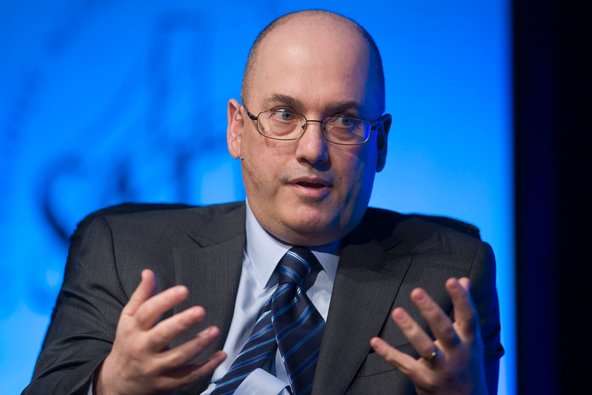I dread reading the following headlines in the NYTimes or the Wall Street Journal – Gargantuan Fines Imposed on Wall Street Institution or Record Breaking Damages Inflicted on Bank. It might as well read => Hugest Biggest Historically Supercalifragilisticexpealidocious Compensatory Damages Imposed on Piteous Bank because of course it means the opposite. The Federal Government after the worst Wall Street Induced Recession of the last 80 years continues to cave and capitulate letting the Street off the hook not for civil but for criminal behaviour of its executives.
The latest Historical Penalty “settlement” is with SAC Capital and its owner, Steven Cohen.
Here is how the NYTimes Dealbook describes the “deal” on Saturday:
The government’s multiyear campaign to ferret out insider trading on Wall Street has yielded multiple prosecutions of former employees of SAC Capital Advisors, the giant hedge fund owned by the billionaire investor Steven A. Cohen. On Friday, federal authorities took aim at the fund itself.In what officials are calling the largest-ever settlement of an insider trading action, SAC agreed to pay securities regulators about $602 million to resolve a civil lawsuit related to improper trading at the fund.
For SAC, which is based in Stamford, Conn., manages $15 billion and holds one of the best investment records on Wall Street, the settlements, while another blow to its reputation, resolve a matter that caused some of its investors to withdraw their money. Investors became skittish last fall after regulators warned SAC that they planned to sue the fund.
… As part of its agreement with regulators, SAC neither admitted nor denied wrongdoing. That entrenched S.E.C. practice — permitting defendants to settle civil claims without acknowledging wrongdoing — has come under increased scrutiny by the courts…
But by Monday, the NYTimes Dealbook was reporting another viewpoint on the “deal”:
Friday’s settlements — for $602 million and $14 million — were criticized by a number of rival hedge fund managers and securities lawyers as not tough enough. Despite the S.E.C.’s trumpeting the $602 million payment as the largest settlement of an insider trading case, critics said that the commission could have sought a harsher punishment.
“While $616 million would normally be a massive penalty, for Cohen this is basically a drop in the bucket,” said Bradley D. Simon, a criminal defense lawyer and former federal prosecutor in New York. “There is also no debarment or admission of wrongdoing.”….
S.E.C. officials made clear on Friday that Mr. Cohen and his employees are not out of the woods. George S. Canellos, the commission’s acting enforcement director, emphasized that the settlements — the first time SAC has settled government allegations — do not prevent future charges against individuals, including Mr. Cohen. Then, speaking broadly, Mr. Canellos said, “There’s a lot more to come in insider-trading cases.”…
Critics of Friday’s settlements say that Mr. Cohen, a multibillionaire who lives in a 35,000-square-foot home in Greenwich, Conn., has bought his way out of trouble. Because SAC has been implicated in numerous insider-trading cases, the critics said, it should face stiffer penalties than a fine with no admission of liability. The settlements still require the approval of a federal judge.
The S.E.C. could have imposed an array of additional punishments, legal experts say. Among other things, it could have named Mr. Cohen as a defendant on a legal theory of control-person liability, alleging that he failed to properly supervise his employees. It also could have sought the revocation of SAC’s securities license and prohibited it from managing money for clients. Even the fine itself could have been substantially higher under securities laws.
For 4 years under the Obama Administration, the DOJ and various Treasury bureaus like the SEC have racked up many civil settlements but with no admission of guilt. The legal actions may impose large fines but the net effect is a)any further civil actions by affected shareholders or other third parties wither on the vine because the “no admission of guilt” with the large fines effectively precludes any other civil actions and b)the lack of criminal actions against financial executives means the “the rule of law” gets short changed because the financial executives behind the malpractices continue to operate with relative impunity. Thus, the same Board of Directors responsible for the 2007-2008 Financial Recession are also implicated in the Foreclosure Scandals or the recent Money Laundering Cases or the LIBOR Rate Malfeasance, etc.
No less a party than Attorney General Eric Holder has effectively added a Too-Big-To-Jail “free pass” to the Too-Big-To-Fail dispensation already granted to the Big Banks and Financial Institutions for the past 4 years by Obama Administration. No wonder Financial Institution have become repeat offenders – the top executive know with near certainty they will get off Scott Free from just about any financial malfeasance they choose to do. At most they will have to pay a fine that most will be able to recover in one or two quarters of earnings.So now you know when and why to cringe – whenever you hear or read about “Historic Financial Fines”.
My gosh, Martha Stewart went to jail for insider trading that is minuscule in comparison to some of the SAC Capital deals. It appears the Obama Administration condones a two tier “rule of law” – relaxed for the large financial institutions, tough for everybody else. And of course the GOP is pip squeak silent about this perversion of justice.

